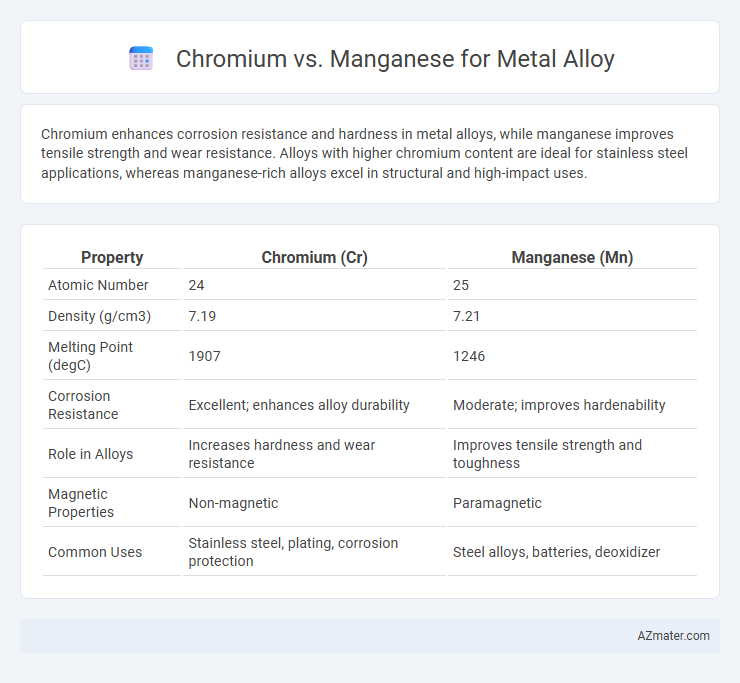Chromium enhances corrosion resistance and hardness in metal alloys, while manganese improves tensile strength and wear resistance. Alloys with higher chromium content are ideal for stainless steel applications, whereas manganese-rich alloys excel in structural and high-impact uses.
Table of Comparison
| Property | Chromium (Cr) | Manganese (Mn) |
|---|---|---|
| Atomic Number | 24 | 25 |
| Density (g/cm3) | 7.19 | 7.21 |
| Melting Point (degC) | 1907 | 1246 |
| Corrosion Resistance | Excellent; enhances alloy durability | Moderate; improves hardenability |
| Role in Alloys | Increases hardness and wear resistance | Improves tensile strength and toughness |
| Magnetic Properties | Non-magnetic | Paramagnetic |
| Common Uses | Stainless steel, plating, corrosion protection | Steel alloys, batteries, deoxidizer |
Introduction to Chromium and Manganese in Metal Alloys
Chromium and manganese are essential elements in metal alloys, each enhancing specific properties for industrial applications. Chromium significantly improves corrosion resistance and hardness, making it a crucial component in stainless steel and wear-resistant alloys. Manganese contributes to strength, toughness, and deoxidation, commonly used in steel production to enhance durability and impact resistance.
Chemical Properties and Reactivity
Chromium exhibits high corrosion resistance and forms a stable oxide layer, making it essential in stainless steel alloys for durability and oxidation resistance. Manganese enhances alloy hardness and tensile strength through its ability to form various carbides and influences deoxidation in steel production due to its moderate reactivity with oxygen and sulfur. Chromium's higher electronegativity and passivation tendency contrast with manganese's role as an active alloying element that improves mechanical properties and wear resistance in metal alloys.
Role in Steel and Iron Alloys
Chromium significantly enhances corrosion resistance and hardness in steel and iron alloys by forming a stable oxide layer and increasing wear resistance. Manganese improves steel toughness and tensile strength while acting as a deoxidizer and sulfur fixer to prevent brittleness during smelting. Both elements are critical in alloy formulation, with chromium mainly contributing to stainless steel properties and manganese optimizing mechanical performance in carbon steels.
Impact on Corrosion Resistance
Chromium significantly enhances corrosion resistance in metal alloys by forming a passive oxide layer that protects the steel surface from oxidation and rust. Manganese contributes to corrosion resistance primarily by improving the alloy's strength and toughness, which helps maintain structural integrity under corrosive conditions but does not form a protective oxide layer. Alloys with higher chromium content generally exhibit superior resistance to oxidation and environmental degradation compared to those with manganese emphasis.
Influence on Mechanical Strength
Chromium improves corrosion resistance and hardenability in metal alloys, significantly enhancing tensile strength and wear resistance. Manganese contributes to strength by increasing toughness and improving ductility through grain refinement and deoxidation. Combining chromium and manganese in alloys results in a balanced enhancement of mechanical properties, optimizing strength and durability for industrial applications.
Effects on Hardness and Durability
Chromium significantly enhances metal alloy hardness by forming a protective oxide layer that increases surface wear resistance and corrosion protection. Manganese improves alloy durability by increasing toughness and resistance to impact, especially in steel, through grain refinement and sulfur stabilization. The combined use of Chromium and Manganese in alloys balances hardness and toughness, optimizing performance in heavy-duty applications.
Importance in Wear and Abrasion Resistance
Chromium significantly enhances wear and abrasion resistance in metal alloys by forming a hard, corrosion-resistant oxide layer that protects surfaces from degradation. Manganese contributes to toughness and impact resistance, improving the alloy's ability to withstand mechanical stresses without fracturing under abrasive conditions. The combination of chromium's hardness and manganese's ductility optimizes durability in demanding industrial applications where wear resistance is critical.
Cost Efficiency and Availability
Chromium offers superior corrosion resistance and hardness, making it a preferred element in stainless steel production despite its higher cost compared to manganese. Manganese is more abundant and generally less expensive, enhancing cost efficiency in low-alloy steel applications where extreme corrosion resistance is not critical. Balancing chromium's durability with manganese's affordability allows manufacturers to optimize metal alloy performance and production budgets effectively.
Environmental and Health Considerations
Chromium and manganese present distinct environmental and health impacts in metal alloys, with hexavalent chromium compounds posing significant toxicity and carcinogenic risks, necessitating strict handling and disposal protocols. Manganese exposure, primarily through inhalation in industrial settings, can lead to neurological effects such as manganism, a condition resembling Parkinson's disease, though it is generally less toxic than chromium. Sustainable alloy manufacturing emphasizes minimizing chromium(VI) emissions and manganese dust exposure to protect worker health and reduce environmental contamination.
Choosing the Right Metal: Chromium vs Manganese
Chromium enhances metal alloys by providing superior corrosion resistance, hardness, and a brilliant finish, making it ideal for stainless steel and wear-resistant materials. Manganese improves alloy toughness, tensile strength, and resistance to abrasion, which is essential in high-strength steel applications like construction and automotive manufacturing. Selecting between chromium and manganese depends on whether corrosion resistance and hardness or toughness and strength are the primary performance criteria for the alloy.

Infographic: Chromium vs Manganese for Metal Alloy
 azmater.com
azmater.com